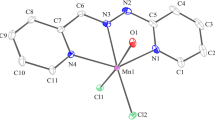Summary.
2,3-Dibromo-6,7,13,14,15,16,22,23-octahydro-14,15-bis-(hydroxyimino)-tribenzo [e,k,q][1,4,7,10,13,16]tetraoxadiazacyclohexadecine (LH4) was prepared by condensation of 1,2-bis-(2′-aminophenoxyethoxy)-4,5-dibromobenzene with cyanogen-di-N-oxide. Mono-, di-, and trinuclear transition metal complexes of this ligand ((LH3)2Ni, (LH3)2Zn, (LH3)2Co, (LH3)2Cu, (LH3)2Fe, (LH3)2(UO2)2(OH)2, (LH)2Cu3, (LH)2Co3) were synthesized under basic conditions. The electrochemical properties of the mono- and dinuclear complexes were studied by cyclic voltammetry in DMSO solution containing TBAP. The results showed that all redox processes are based on the metal center and the oxime ligands stabilize the Ni(III), Fe(III), Co(III), and Cu(III) species formed during oxidation. The Fe(II) and U(VI)O2 complexes displayed a different behaviour: a reduction peak with the corresponding anodic signal during the reverse scan was observed. The oxime moiety also stabilizes U(V)O2 which forms during the reduction process of the uranyl complex. Cu(II) was adsorbed on the electrode surface upon scanning cathodically.
Similar content being viewed by others
Author information
Authors and Affiliations
Additional information
Received August 20, 2001. Accepted (revised) October 17, 2001
Rights and permissions
About this article
Cite this article
Yılmaz, İ., Kandaz, M., Özkaya, A. et al. Synthesis, Characterization, and Electrochemical Properties of a Novel Macrocylic Ligand and its Transition Metal Complexes. Monatshefte fuer Chemie 133, 609–622 (2002). https://doi.org/10.1007/s007060200033
Issue Date:
DOI: https://doi.org/10.1007/s007060200033




